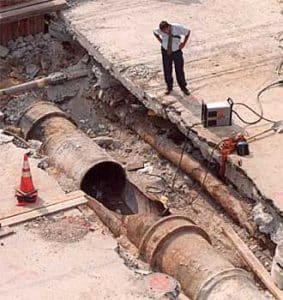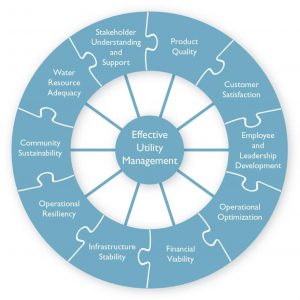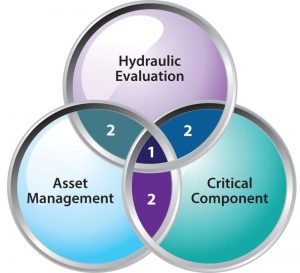Effective Water and Wastewater Utility Management

As water and wastewater utilities nationwide face an increasing number of challenges, including rising costs and population, aging infrastructure, drought, increasingly stringent regulatory requirements, and a rapidly changing workforce, creative and innovative methodologies for treatment and distribution along with efficient and effective utility management have become paramount. In order to ensure a strong and viable utility for future generations, utilities must find ways to improve their products and services while increasing community support. Effective water and wastewater utility management helps utilities improve performance in critical areas while responding to current and future challenges, all with limited infrastructure dollars.
In May of 2007, six major water and wastewater associations and the U.S. Environmental Protection Agency signed an historic agreement pledging to support effective utility management collectively and individually throughout the water sector and to develop a joint strategy to identify, encourage, and recognize excellence in water and wastewater utility management. Participating organizations included the following:
- Association of Metropolitan Water Agencies (AMWA)
- American Public Works Association (APWA)
- American Water Works Association (AWWA)
- National Association of Clean Water Agencies (NACWA)
- National Association of Water Companies (NAWC)
- United States Environmental Protection Agency (EPA)
- Water Environment Federation (WEF)
The result of this powerhouse collaboration was the Effective Utility Management Primer, issued in June of 2008. The Primer, designed specifically to assist water and wastewater managers in identifying and addressing their most urgent needs through a customized, incremental approach, outlines ten attributes of effectively managed utilities along with five keys to management success:
Ten Attributes of Effectively Managed Water Sector Utilities
 Product Quality produces potable water, treated effluent, and process residuals in full compliance with regulatory and reliability requirements and consistent with customer, public health, and ecological needs.
Product Quality produces potable water, treated effluent, and process residuals in full compliance with regulatory and reliability requirements and consistent with customer, public health, and ecological needs.- Customer Satisfaction provides reliable, responsive, and affordable services in line with explicit, customer- accepted service levels. Receives timely customer feedback to maintain responsiveness to customer needs and emergencies.
- Employee and Leadership Development recruits and retains a workforce that is competent, motivated, adaptive, and safe-working. Establishes a participatory, collaborative organization dedicated to continual learning and improvement. Ensures employee institutional knowledge is retained and improved upon over time. Provides a focus on and emphasizes opportunities for professional and leadership development and strives to create an integrated and well-coordinated senior leadership team.
- Operational Optimization ensures ongoing, timely, cost-effective, reliable, and sustainable performance improvements in all facets of its operations. Minimizes resource use, loss, and impacts from day-to-day operations. Maintains awareness of information and operational technology developments to anticipate and support timely adoption of improvements.
- Financial Viability understands the full life-cycle cost of the utility and establishes and maintains an effective balance between long-term debt, asset values, operations and maintenance expenditures, and operating revenues. Establishes predictable rates—consistent with community expectations and acceptability—adequate to recover costs, provide for reserves, maintain support from bond rating agencies, and plan and invest for future needs.
- Infrastructure Stability understands the condition of and costs associated with critical infrastructure assets. Maintains and enhances the condition of all assets over the long-term at the lowest possible life-cycle cost and acceptable risk consistent with customer, community, and regulator-supported service levels, and consistent with anticipated growth and system reliability goals. Assures asset repair, rehabilitation, and replacement efforts are coordinated within the community to minimize disruptions and other negative consequences.
- Operational Resiliency ensures utility leadership and staff work together to anticipate and avoid problems. Proactively identifies, assesses, establishes tolerance levels for, and effectively manages a full range of business risks (including legal, regulatory, financial, environmental, safety, security, and natural disaster-related) in a proactive way consistent with industry trends and system reliability goals.
- Community Sustainability is explicitly cognizant of and attentive to the impacts its decisions have on current and long-term future community and watershed health and welfare. Manages operations, infrastructure, and investments to protect, restore, and enhance the natural environment; efficiently uses water and energy resources; promotes economic vitality; and engenders overall community improvement. Explicitly considers a variety of pollution prevention, watershed, and source water protection approaches as part of an overall strategy to maintain and enhance ecological and community sustainability.
- Water Resource Adequacy ensures water availability consistent with current and future customer needs through long-term resource supply and demand analysis, conservation, and public education. Explicitly considers its role in water availability and manages operations to provide for long-term aquifer and surface water sustainability and replenishment.
- Stakeholder Understanding and Support engenders understanding and support from oversight bodies, community and watershed interests, and regulatory bodies for service levels, rate structures, operating budgets, capital improvement programs, and risk management decisions. Actively involves stakeholders in the decisions that will affect them.
Five Keys to Management Success
 Leadership
Leadership
Leadership is critical to effective utility management, particularly in the context of driving and inspiring change within an organization. Leadership refers both to individuals who can be effective champions for improvement, and to teams that provide resilient, day-to-day management continuity and direction. Effective leadership ensures that the utility’s direction is understood, embraced, and followed on an ongoing basis throughout the management cycle.- Strategic Business Planning
Strategic business planning is an important tool for achieving balance and cohesion across the Attributes. A strategic plan provides a framework for decision making by assessing current conditions, strengths and weaknesses; assessing underlying causes and effects; and establishing vision, objectives, and strategies. It establishes specific implementation steps that will move a utility from its current level of performance to achieving its vision. - Organizational Approaches
There are a variety of organizational approaches that contribute to overall effective utility management and that are critical to the success of management improvement efforts, including actively engaging employees in improvement efforts; deploying an explicit change management process that anticipates and plans for change and encourages staff at all levels to embrace change; and utilizing implementation strategies that seek, identify, and celebrate victories. - Measurement
Measurement is critical to management improvement efforts and is the backbone of successful continual improvement management and strategic business planning. A measurement system serves many vital purposes, including focusing attention on key issues, clarifying expectations, facilitating decision making, and, most importantly, learning and improving. - Continual Improvement Management Framework
A continual improvement management framework can help utilities understand improvement opportunities and establish explicit service levels, guide investment and operational decisions, form the basis for ongoing measurement, and provide the ability to communicate clearly with customers and key stakeholders. This framework plays a central role in effective utility management and is critical to making progress.
OK – Now What?
 So how does a utility assess, address, and implement these changes? The primer further recommended an assessment tool with five steps, for which the instructions comprise the latter 35 pages of the Effective Utility Management Primer. Admittedly, the entire process requires dedicated time and personnel commitment from the utility. While some utility managers have had success in applying the assessment to their utility, many have found the process to require resources simply unavailable to them. Tata & Howard has developed two proprietary innovations that assist water and wastewater utilities in the identification of their most urgent needs as well as effective and efficient utility management.
So how does a utility assess, address, and implement these changes? The primer further recommended an assessment tool with five steps, for which the instructions comprise the latter 35 pages of the Effective Utility Management Primer. Admittedly, the entire process requires dedicated time and personnel commitment from the utility. While some utility managers have had success in applying the assessment to their utility, many have found the process to require resources simply unavailable to them. Tata & Howard has developed two proprietary innovations that assist water and wastewater utilities in the identification of their most urgent needs as well as effective and efficient utility management.
Business Practice Evaluations
Business Practice Evaluations (BPEs) assess the health of a utility’s work practices by implementing a framework for a structured approach to managing, operating, and maintaining in a more business-like manner. This assessment provides the information and planning required by the Primer, specifically in the Five Keys to Management Success. A BPE’s primary focus is on effective management.
The overall goal of the assessment process is more efficient and effective work practices, and the assessment process and tools developed enable utility managers to assess the efficiency and effectiveness of the utility in comparison to generally accepted industry standards. The assessment includes documentation of current business practices, identification of opportunities for improvement, conducting interviews including a diagonal slice of the organization, and observation of work practices in the field. From this assessment we make recommendations to improve system performance, and the structured approach is fully customized and includes all functions of the utility — from administration and technical to operations and maintenance. The assessment process allows utility executives to proactively develop system specific plans, programs, and timelines to optimize the overall utility system programs.
Capital Efficiency Plans™
 Where BPEs focus on management, Capital Efficiency Plans™ (CEPs) address the utility itself, combining the concepts of hydraulic modeling, system criticality, and asset management into a single comprehensive report. Each report is customized to the individual utility system and provides utilities with a database and Geographic Information System (GIS) representation for each pipe segment within their underground piping system. The CEP report also prioritizes system piping improvements and provides estimated costs for replacement and rehabilitation.
Where BPEs focus on management, Capital Efficiency Plans™ (CEPs) address the utility itself, combining the concepts of hydraulic modeling, system criticality, and asset management into a single comprehensive report. Each report is customized to the individual utility system and provides utilities with a database and Geographic Information System (GIS) representation for each pipe segment within their underground piping system. The CEP report also prioritizes system piping improvements and provides estimated costs for replacement and rehabilitation.
Each water and wastewater system has unique characteristics and challenges that are discussed at our CEP workshop held with knowledgeable field staff and managers for each project. The workshops provide significant value by filling in data gaps, correcting incorrect records, and identifying specific issues and critical components that are custom to the system. Our completed studies have been well received by many utilities who have found our methodology not only practical and understandable, but also defendable when justifying projects and procuring funding.
In Conclusion
Water and wastewater utilities today are finding themselves increasingly burdened with decreased revenue, excessive demand, and crumbling infrastrucure. Strict new regulations and a changing workforce have also added to the challenge, and it is imperative that water and wastewater utilities find ways to efficiently and effectively improve systems while implementing successful management strategies. Targeted assessments, strategic planning, and identification and implementation of best practices will be the foundation of all successful utilities in the future.
